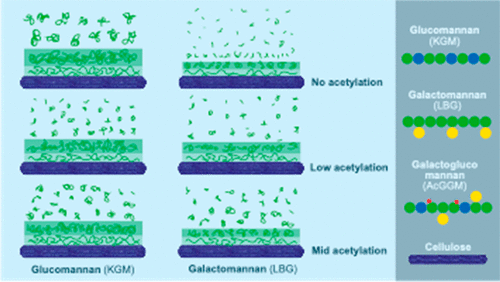当前位置:
X-MOL 学术
›
ACS Sustain. Chem. Eng.
›
论文详情
Our official English website, www.x-mol.net, welcomes your feedback! (Note: you will need to create a separate account there.)
Acetylation and Sugar Composition Influence the (In)Solubility of Plant β-Mannans and Their Interaction with Cellulose Surfaces
ACS Sustainable Chemistry & Engineering ( IF 8.4 ) Pub Date : 2020-06-15 , DOI: 10.1021/acssuschemeng.0c01716 Jennie Berglund 1, 2 , Saina Kishani 1, 2 , Danila Morais de Carvalho 1 , Martin Lawoko 1, 2 , Jakob Wohlert 1, 2 , Gunnar Henriksson 1, 2 , Mikael E. Lindström 1, 2 , Lars Wågberg 1, 2 , Francisco Vilaplana 2, 3
ACS Sustainable Chemistry & Engineering ( IF 8.4 ) Pub Date : 2020-06-15 , DOI: 10.1021/acssuschemeng.0c01716 Jennie Berglund 1, 2 , Saina Kishani 1, 2 , Danila Morais de Carvalho 1 , Martin Lawoko 1, 2 , Jakob Wohlert 1, 2 , Gunnar Henriksson 1, 2 , Mikael E. Lindström 1, 2 , Lars Wågberg 1, 2 , Francisco Vilaplana 2, 3
Affiliation

|
Plant β-mannans are complex heteropolysaccharides that represent an abundant resource from lignocellulosic biomass. The influence of the molecular motifs of plant mannans on the backbone flexibility, solubility, and the interaction with cellulose was investigated by computational and experimental approaches. The regioselectivity of the acetyl substitutions at C2 and C3 distinctively influenced backbone flexibility in aqueous media, as revealed by molecular dynamic simulations. The molecular weight and degree of acetylation were tailored for two model seed mannans (galactomannan and glucomannan) and compared to spruce acetylated galactoglucomannan. The thermal stability was enhanced with increasing acetyl substitutions, independently of the type of mannan. Dynamic light scattering and atomic force microscopy revealed that the occurrence of galactosylation and a low degree of acetylation (similar to that of native acetylated galactoglucomannans) enhanced solubility/dispersibility of mannans, whereas the solubility/dispersibility decreased for higher degrees of acetylation. Mannan solubility influenced their interactions with cellulose at water–cellulose interfaces in terms of adsorbed mass and viscoelastic properties of the adsorbed mannan layers. Our results reveal that modulating the molecular motifs of plant β-mannans influences their macromolecular conformation and physicochemical properties, with fundamental implications for their role in the plant cell wall and the design of wood-based materials.
中文翻译:

乙酰化和糖组成影响植物β-甘露聚糖的(溶解)溶解度及其与纤维素表面的相互作用
植物β-甘露聚糖是复杂的杂多糖,代表了来自木质纤维素生物质的丰富资源。通过计算和实验方法研究了植物甘露聚糖分子基序对骨架柔性,溶解度以及与纤维素相互作用的影响。分子动力学模拟显示,在C2和C3处的乙酰基取代基的区域选择性显着影响水介质中的骨架柔性。针对两种模型种子甘露聚糖(半乳甘露聚糖和葡甘露聚糖)量身定制了分子量和乙酰化程度,并与云杉乙酰化的半乳葡甘露聚糖进行了比较。无论甘露聚糖的类型如何,随着乙酰基取代的增加,热稳定性得到增强。动态光散射和原子力显微镜显示,半乳糖基化的发生和低乙酰化程度(类似于天然乙酰化半乳葡甘露聚糖的发生)增强了甘露聚糖的溶解度/分散性,而更高程度的乙酰化度则溶解度/分散度降低。甘露聚糖的溶解度影响了它们在水-纤维素界面上与纤维素的相互作用,这取决于甘露聚糖层的吸附质量和粘弹性。我们的研究结果表明,调节植物β-甘露聚糖的分子基序会影响其大分子构象和理化性质,并对它们在植物细胞壁和木质材料设计中的作用具有根本意义。
更新日期:2020-07-13
中文翻译:

乙酰化和糖组成影响植物β-甘露聚糖的(溶解)溶解度及其与纤维素表面的相互作用
植物β-甘露聚糖是复杂的杂多糖,代表了来自木质纤维素生物质的丰富资源。通过计算和实验方法研究了植物甘露聚糖分子基序对骨架柔性,溶解度以及与纤维素相互作用的影响。分子动力学模拟显示,在C2和C3处的乙酰基取代基的区域选择性显着影响水介质中的骨架柔性。针对两种模型种子甘露聚糖(半乳甘露聚糖和葡甘露聚糖)量身定制了分子量和乙酰化程度,并与云杉乙酰化的半乳葡甘露聚糖进行了比较。无论甘露聚糖的类型如何,随着乙酰基取代的增加,热稳定性得到增强。动态光散射和原子力显微镜显示,半乳糖基化的发生和低乙酰化程度(类似于天然乙酰化半乳葡甘露聚糖的发生)增强了甘露聚糖的溶解度/分散性,而更高程度的乙酰化度则溶解度/分散度降低。甘露聚糖的溶解度影响了它们在水-纤维素界面上与纤维素的相互作用,这取决于甘露聚糖层的吸附质量和粘弹性。我们的研究结果表明,调节植物β-甘露聚糖的分子基序会影响其大分子构象和理化性质,并对它们在植物细胞壁和木质材料设计中的作用具有根本意义。


























 京公网安备 11010802027423号
京公网安备 11010802027423号